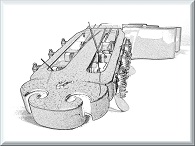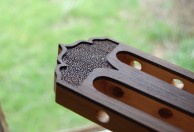Welcome to one of the most active flamenco sites on the Internet. Guests can read most posts but if you want to participate click here to register.
This site is dedicated to the memory of Paco de Lucía, Ron Mitchell, Guy Williams, Linda Elvira, Philip John Lee, Craig Eros, Ben Woods, David Serva and Tom Blackshear who went ahead of us.
We receive 12,200 visitors a month from 200 countries and 1.7 million page impressions a year. To advertise on this site please contact us.
|

|
|
The Advantages of Laminating Guitar Sides
|
You are logged in as Guest
|
|
Users viewing this topic: none
|
|
Login  | |
|

   
rojarosguitar
Posts: 243
Joined: Dec. 8 2010

|
 RE: The Advantages of Laminating Gui... (in reply to Haithamflamenco) RE: The Advantages of Laminating Gui... (in reply to Haithamflamenco)
|
|
|
This is from a different guitar department, but anyway: I could see almost every guitar Sebastian Stenzel (a quite well known German classical guitar maker) made since many years.
Usually he makes them all solid, but, from time to time he laminates the sides (not the back, and always with parallel grain). Both layers were a bit thinner than with solid sides, but together they were slightly thicker and heavier than a solid side. For him it was definitely one more step in the making process and not a simplification, so these guitars actually could be even slightly more expensive, but I can't remember him saying abut charging a higher price, but that doesn't mean he didn't.
His guitars are very consistent in tonal quality, they carry his signature, no doubt. So the guitars with the laminated sides didn't deviate that much from what I know as a Stenzel guitar, but they were different. They seemed to project forward stronger, whereas they appeared slightly more distant for the player.
_____________________________
Music is a big continent with different lascapes and corners. Some of them I do visit frequently, some from time to time and some I know from hearsay only ...
A good musical instrument is one that inspires one to express as free as possible
|
|
|
|
REPORT THIS POST AS INAPPROPRIATE |
Date May 30 2014 7:19:55
 |
|

   
estebanana
Posts: 9370
Joined: Oct. 16 2009

|
 RE: The Advantages of Laminating Gui... (in reply to Haithamflamenco) RE: The Advantages of Laminating Gui... (in reply to Haithamflamenco)
|
|
|
I think the deal with laminated sides is that they help create a stiffer rim in combination with a solid liner. The movement of the top does also move the sides, the laminated sides can act as a stable, less yielding structure for the top to be attached to. The result is less energy is transferred from the top into making the sides vibrate. With a rim not effected or moved by the torsion of the flexing top the it enables the top movement to focus more energy to the bridge.
For the kind of sound you want to get for the 'archetypal flamenco guitar' you want some of the vibration to be absorbed into the ribs and for the ribs to be thin. The effect is a kind of filtering through the rib structure which saps a bit of energy from the top. The result is that dispersion of top energy to other parts of the guitar help make part of the core sound. That idea works in combination with how the top moves a lot in the cross grain direction. The tone generation builders even identify that kind of motion as the cross di-pole mode. It's the amount of stiffness and flexibility in the top between the wings of the bridge and the edges. That is a key area for setting up a "flamenco" sound. ( I call it the Goldilocks area because it can't be too soft of too hard, or too flexible or too stiff, it has t be just right. )
You can still get that "flamenco" sound with laminated ribs, but really, really stiff heavy ribs generally won't allow you to build with as much sensitivity to the rib and top and cross di-pole area. There is a lot to be said for how you couple the top to the ribs and how flexible or stiff they are. Much of that stuff is not quantifiable, a few people write books about and tell you that it is, but you can build a guitar a lot of different ways and still come out with a good instrument.
Daniel Freiderich the great French maker uses laminated ribs, quite thick in fact, in some cases I've read and seen plans with ribs up to 4mm thick! But you don't see many or any flamenco guitars by him. I also like Bogdanovich, he's got a lot of good ideas and he's not as dogmatic as it looks on the surface. I think he just talks from his own experience an as we know, guitar makers have strong opinions. His ideas to me are not answers to anything, because for me they bring up more questions than they answer. And some of the questions may not have answers I can practically find out. One big question I've always had is: Does the rib structure relax over time? We try to fit it as best we can and touch them up on the bending iron, but you know that the cypress (and some other woods) ribs are fighting back after they are glued in place. How long do they fight, weeks, months, years? Do they relax eventually and does that something to the sound?
You can speculate, or you can build five guitars and then disassemble them one by one in timed sequence,week, month three months, six months a year and see if the ribs still have memory of when they were flat. But who would do that? And what would it prove? How can you empirically test to see if relaxation of the rib structure changes the sound?
There are so many things that are unknowable; guitar making theory boils down to a few simple things in the end.
You get anecdotal diagnosis of problems and things that someone thinks works. And you get experience working the same model or a few models of guitar over and over and you learn by trial and error what works. There a few problems that have been worked out empirically by testing, but a great many things remain untestable, liners vs. glue blocks is a good one. There's no real way to test that so what you get is whole bunch of anecdotal information based on observations by different builders.
As good friend of mine likes to say: "Talking about guitar making is like kissing in a whorehouse."
_____________________________
https://www.stephenfaulkguitars.com
|
|
|
|
REPORT THIS POST AS INAPPROPRIATE |
Date May 31 2014 17:16:10
 |
|
 New Messages New Messages |
 No New Messages No New Messages |
 Hot Topic w/ New Messages Hot Topic w/ New Messages |
 Hot Topic w/o New Messages Hot Topic w/o New Messages |
 Locked w/ New Messages Locked w/ New Messages |
 Locked w/o New Messages Locked w/o New Messages |
|
 Post New Thread
Post New Thread
 Reply to Message
Reply to Message
 Post New Poll
Post New Poll
 Submit Vote
Submit Vote
 Delete My Own Post
Delete My Own Post
 Delete My Own Thread
Delete My Own Thread
 Rate Posts
Rate Posts
|
|
|
Forum Software powered by ASP Playground Advanced Edition 2.0.5
Copyright © 2000 - 2003 ASPPlayground.NET |
7.800293E-02 secs.
|


 Printable Version
Printable Version

















 New Messages
New Messages No New Messages
No New Messages Hot Topic w/ New Messages
Hot Topic w/ New Messages Hot Topic w/o New Messages
Hot Topic w/o New Messages Locked w/ New Messages
Locked w/ New Messages Locked w/o New Messages
Locked w/o New Messages Post New Thread
Post New Thread